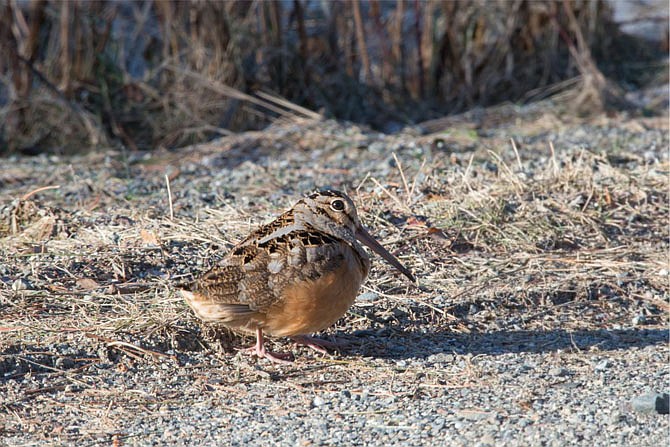To See Woodcocks
Huntley Meadows Park has six woodcock walks scheduled in March. Visit https://www.fairfaxcounty.gov/parks/parktakes.
Occoquan National Wildlife Refuge has no organized walks. The visitor center is open Thursdays through Saturdays, 10 a.m. to 4 p.m.
They are the dazzling Casanovas of the bird world, American woodcocks, sandpiper-like, rotund, tawny brown birds with a three-inch bill. The males woo females – and enthrall their human fans -- with their elaborate whirl-a-gig and plummeting “sky dance.”
In the spring at dawn and dusk, usually late February to March in Northern Virginia, woodcock wonders ensue. Male woodcocks give a buzzy “peent” call and launch into the air in a twisting flight display and then spiral down to the ground. As they ascend, they make a twittering sound, which is produced by the air moving between their outer wing feathers. As they zigzag down, they chirp and land, ideally near an interested female.
These six-to-seven-ounce birds have also been called timberdoodles, Labrador twisters, night partridges and bog suckers. Plump, short-necked birds, woodcocks can be difficult to see on the ground because their brown and gray tones camouflage the bird among the leaves, grasses and woody materials. They probe the soil searching for earthworms and other invertebrates.
Woodcocks choose forests, forest edges, shrubby areas near fields and wet meadows for their mating sites. Females make a shallow depression for a nest in the leaf and twig litter and lay from one to five eggs. “Males mate with multiple females and give no parental care,” says Cornell University’s All about Birds. Young woodcocks can search for their own food in three to four days.
Population Declines
According to the U.S. Fish and Wildlife Service, woodcock numbers “had a significant negative trend over the most recent 10 years (2013–2023),” declining 1.18 percent each year in the eastern U.S. The North American Breeding Bird Survey also shows a drop in their numbers between 1966 and 2019.
Hunted in Virginia
Virginia’s Department of Wildlife Resources (DWR) classifies American woodcocks as game birds and allows them to be hunted between Nov. 10 and 27 and Dec. 26 to Jan. 21. DWR’s “bag limit” allows one to kill three per day or nine in possession. “Possession” refers to those you have on your person, in a vehicle or in your home.
Where to See Them?
Lucky woodcock loyalists and woodcock newbies may see these birds at Huntley Meadows Park and the Occoquan National Wildlife Refuge this time of year. There are records of woodcocks at Theodore Roosevelt Island, Great Falls Park and Dyke Marsh, say National Park Service officials. They may be in other areas, but not documented.
Weather can be a factor in seeing or hearing them, says P.J. Dunne, staff naturalist at Huntley Meadows Park. He reports, “Wind higher than around 10 or 15 miles per hour tends to keep the woodcocks from displaying. As part of their mating flight, they can fly as high as 300 feet. Once they clear the tops of the trees, the wind wreaks havoc on their flight. They prefer calmer conditions, where the flight and the sounds they make with their wings and vocalizations are easier heard by the females.” Heavy rains can deter them as well. Cold weather can push their mating and breeding a few weeks beyond their normal mating display period, late February into mid-March.
At Huntley Meadows Park, woodcocks typically display mating behavior in the meadows accessed from Kings Highway. Dunne says, “The mating flight of the woodcock is an amazing experience and can only be seen after the park is normally closed. Visitors have come up to me many years after their first experience seeing the woodcock flight on one of our programs and said it is an experience they will never forget and they can't wait to see them again.”
Conservationist Aldo Leopold wrote that the woodcock’s mesmerizing, mating sky dances were “a refutation of the theory that the utility of a game bird is to serve as a target or to pose gracefully on a slice of toast.”
